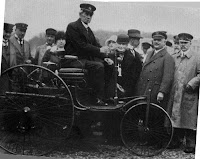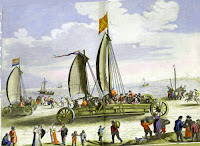History of cars from the earliest times and today
The car is better known under the nickname "Car". It referred to a motor-driven, multi-track motor vehicle, transported to the persons or cargo, or be transported. The term originated in the late 19th century and comes from the French. Judging by the definition so are trucks and cars, but cars are in common usage only called cars. Before there were cars came wagons drawn by draft animals are used. However, these have been quickly replaced by cars. The reasons are quite simple: Automobiles are a lot faster, so you can go in a short time further and are therefore much more powerful than, say, a horse-drawn carriage. The stock of cars in the world has steadily increased, in 2007, he was around 918 million pieces. The following is about the invention and development of the automobile to the current models.
The first developments of cars
A prerequisite for the development of the cars was initially the invention of the wheel, which was held simultaneously in different cultures around 4000 years before Christ. From this we developed the first car or the precursor of the cars.
It is unclear exactly where the first car was built. One theory is that it should have been in Central Europe. The first known trolley are the Hellenic siege towers of about 400 BC, the people of the car Demetrius of Phalerum of 308 BC and the cars from the Roman Empire. The common feature of these cars precursor is that they had to be driven either by humans or animals. However, already a monk in the 13th century said that there will be one day carts, "the move and keep moving without being pushed or pulled by any animal."
And he was right. But for now, the development went into Germany via a so-called muscle cars. First evidence can be found from the year 1447. Leonardo da Vinci drew then around 1490 a first armored cars that could drive itself. But the first model, which was really useful as automobile was built only in 1600 in the Netherlands. The mathematician Simon Stevin designed a sail car, which was moving along on the basis of wind energy and could carry up to thirty people.
Model steam engine

The first piston engine was invented by the Dutch physicist Christiaan Huygens also in 1674th Huygens is considered the inventor of the piston engine and thus a pioneer of internal combustion engines according to the principle of which still work today Motors. His piston engine had a combustion engine, which has been operated with the fuel gunpowder. The next step came in 1680 when the physicist Isaac Newton in England a steam car designed. Ten years later, a high-pressure steam engine was built with pistons in France, which was in 1712 again developed in England.
Thomas Newcomen had the idea already to produce the steam outside the cylinder, thereby laying the foundation for the well-known direct-acting steam engine by the Scottish physicist James Watt by 1768. The short time later developed steam car of the French military engineer Nicolas Joseph Cugnot even reached already a rate of three to four kilometers per hour.
The next development made Richard Trevithick in 1797 with a steam car model in which the boiler heating was performed using a hot iron rod, which is inserted into the flame tube. He also constructed the "Puffing Devil" a car with a steam drive, with passengers up to eight km / h drove and could even handle slopes. Using a similar model there from 1828 in England already a Dampfbus who commuted between London and Bath. Following this example, Walter Hancock built steam car for private individuals and steam omnibuses.
New engine types
The first electric car was built in 1839 by Robert Anderson and the first gas engine allowed the Frenchman Etienne Lenoir patented 1860th Between 1862 and 1866 invented Nikolaus August Otto the first four-stroke gas engine, which he patented ten years on it as the famous four-stroke petrol engine. At the same time experimented Siegfried Marcus with a compression-less two-stroke engine, which was screwed onto a handcart.
The birth of the car
 The development of the cars, as we know it today, was only progressing properly when Carl Benz
The development of the cars, as we know it today, was only progressing properly when Carl Benz Regardless of which also Gottlieb Daimler, Wilhelm Maybach and Siegfried Marcus developed their vehicles. Between 1894 and 1902 Benz nevertheless put forth a first production car. Besides, the Daimler-Motoren-Gesellschaft was founded and Daimler developed a coach car, which was up to 16 km / h. Together with the engine builder Maybach he built many vehicles. Irrespective of the other inventions designed Siegfried Marcus 1888-1889 a car that was powered by a gasoline four-stroke engine, which was already similar to today's car. 1897 Rudolf Diesel developed the first diesel engine and in 1889 by the Austrian automobile manufacturers Gräf & Stift built the first car with front-wheel drive, which was patented in 1900
registered his three-wheeled vehicle with gas engine for a patent on 29 January 1886th The first cross-country trip with the Benz Patent Motor Car no. 3 of Bertha Benz in 1888 went down in history. Today the Bertha Benz Memorial Route commemorates this pioneering journey.
Just one year later the speed of 100 km / hr was achieved using an electric car by Camille Jenatzy. Against the various types of drives for cars are ultimately able to prevail the gasoline automobile. The reasons are to this day still relevant and understandable. The technology of the engine is very advanced and the oil as a fuel has a very high energy density, whereby the vehicle covers a large area. In addition, the fuel was still extremely cheap. The basic mechanics of the first car has hardly changed until today, but since the 1920s have been added countless technical innovations.
The technical advancements to 1950
 In Germany in 1901 developed Mercedes-Simplex was the basis for most vehicles produced. Models according to the Simplex had the engine in front and a transmission and drive shafts to the wheels. The name Simplex would incidentally by Kaiser Wilhelm II. Invented during a motor show, the titled the ten minute startup of a Mercedes car compared to the duration of the arduous chucking the horses in a carriage as Simplex. As early as 1903 the first sports car was built. The Spyker 60/80 HP differed by its all-wheel drive of all other vehicles.
In Germany in 1901 developed Mercedes-Simplex was the basis for most vehicles produced. Models according to the Simplex had the engine in front and a transmission and drive shafts to the wheels. The name Simplex would incidentally by Kaiser Wilhelm II. Invented during a motor show, the titled the ten minute startup of a Mercedes car compared to the duration of the arduous chucking the horses in a carriage as Simplex. As early as 1903 the first sports car was built. The Spyker 60/80 HP differed by its all-wheel drive of all other vehicles. That same year, the first patent for windscreen wipers has been granted, which were developed by Mary Anderson. Gräf & Stift built two prototypes of its front-wheel drive model. Shortly thereafter, the disc brake was invented by Frederick Lanchester, the first production car with disc brakes but there was not until 1955 with the Citroën DS. From 1904 to 1928, establishes a Thuringian automotive company cars that were exported to the United States. The brand names were "Appollo" and "Piccolo".
1913 invented the American entrepreneur Henry Ford assembly line production. Now affordable cars could be mass produced, resulting in a significant increase in sales. A year later came the first hydraulic braking system on the market and since 1918 chassis and body made of steel were manufactured. In 1923, there were prepared the first truck with a diesel engine. In Germany, the assembly line production of cars in 1924 began with the Opel tree frog and just two years later, the Daimler-Benz AG founded, since the company Benz & Co. and Daimler-Motoren-Gesellschaft merged. 1931 followed shortly after the Great Depression of the DKW F1 with front wheel drive in series. The rotary engine was developed in 1933 and seven years later was led ever the automatic transmission. After a longer break until 1948. Development of radial tires or radial tires came on the market. 1949 took place in Berlin again the first car exhibition held after the end of World War II. Venue were the exhibition halls at the radio tower.
The fine-tuning of the 1950s to the present day
The next major developments were the gasoline direct injection system and power steering. The
former was the first time in the Gutbrod Superior and Goliath GP 700 Sport in 1951 used. The power steering was offered by the American company Chrysler in the same year. From 1957 it was possible to install optional safety lap belts. At that time, the security conditions were very bad in cars and the development of this first lap belts was extremely progressive. In 1963, a car was built six years later with a rotary engine, which is also called a rotary engine, and only a year later, the electronic fuel injection system was developed. Extremely startling was the first trip with a car on the Moon on August 1, 1970 by an American astronaut. Subsequently, the Subaru Leone in 1972 was the first in series produced car with all-wheel drive for the streets of the Earth.
Next, developed General Motors from 1974, the first autocatalysts for gasoline engines and in 1978 the fully electronic anti-lock brake system (ABS) has been launched in the S-Class from Mercedes. In the 1980s, the first vehicles were produced with airbags and from 1984 was adjusted for the first time natural gas vehicles in series ago. With the technical innovations for diesel engines, it was only in 1990 further developed as appropriate catalysts. The introduction of the electronic stability program (ESP) took place in 1995. After the Moose Test debacle of the A-Class from Mercedes in 1997, the ESP pioneered peu à peu the way of the absolute luxury class through to the mass-produced, cheaper model classes.
In the same year the first car with hybrid drive therefore a combined electric and combustion engines in series production were. The undisputed precursor here was the Japanese carmaker Toyota with its Prius models.
Today's car and its future
Today the car a lot safer and more efficient than it was a century ago. The design has changed very strongly, at the beginning of the vehicles were more like horse-drawn carriages and today they look in comparison like spaceships from. In the further development, there are, however, different tendencies. It is already foreseeable that the equipment with electronic information, such as navigation systems or entertainment media will be accentuated. But equally important is the innovation departments of the car manufacturers further reduction in fuel consumption or even the change to a different type of drive. Then there is the aspect that the increased use should be driven by renewable resources. But Technologically, the areas of driver assistance systems, steer-by-wire / brake-by-wire and fuel cell, electric and hybrid drive at the latest. They are the most important innovation areas to be explored and competitive manner. Other ideas are the pedestrian protection and the driverless transportation system.


